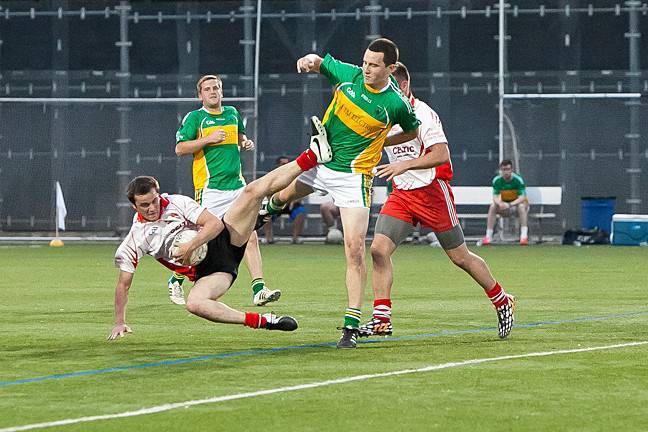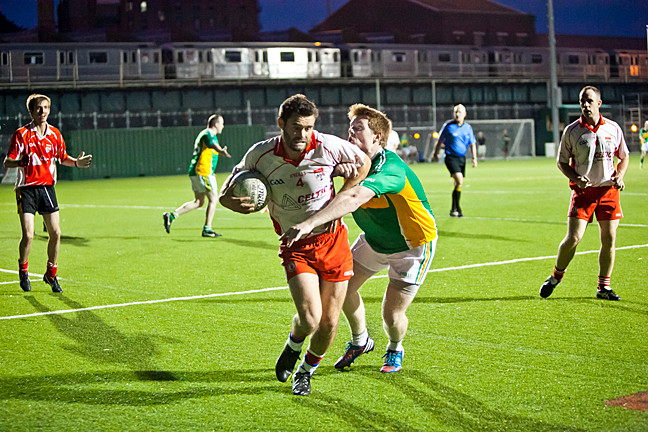Emerald Isle’s game sparkles in Riverdale
Connor Skeffington’s hair glistened with sweat as he exited a one-room trailer that served as team Tyrone’s locker room for its Gaelic football match on July 10 against St. Barnabas.
Rushing to do an interview, the bare-chested Skeffington threw on a teammate’s jersey with a Gaelic motto translated as, “There is no strength without unity.”
Tyrone, which is in the Intermediate Football Division of the Gaelic Athletic Association (GAA) of Greater New York, had just won its first game of the season, 17-16, with Skeffington scoring the decisive goal with 4:30 left in the second half. The team trailed by six points with less than 15 minutes to play, a usually insurmountable lead.
In Gaelic football, one point is awarded for kicking the ball above the crossbar and between the goalposts that shoot up from both ends of a soccer net. If a player kicks the ball into the net, which is guarded by a goalkeeper, it is a three-point goal. At the time of Skeffington’s three-point goal, Tyrone led 14-12 in points, but trailed 15-14 because of St. Barnabas’ goal at the 17:42 mark of the second half.
Skeffington ripped a right-footed shot that beat the keeper to the far side to give Tyrone the lead for good.
“I’ve been watching the World Cup this past month and I finally had a bit of World Cup fever, you know?” the 30-year-old construction worker said of his kick.
To the uninitiated, Gaelic football looks like rugby with a twist. It has elements of basketball, soccer, volleyball and even American football. Players can take a maximum of four steps with the ball, unless they dribble it to themselves off their foot, and then either kick, bounce or bump it to a teammate.
The GAA of Greater New York hosts its matches at Manhattan College’s Gaelic Park, just underneath the Van Cortlandt Park subway stop. Admission is $5, and while Thursday’s crowd was sparse, it was spirited, as some of the spectators enjoyed an adult beverage.
There are volunteer referees under the goalposts to make sure a kick is good and another official with a flag on the sideline to determine possession when the ball goes out of bounds. There is also an announcer who you may have trouble understanding if you are not from the old country.
As Tyrone and St. Barnabas battled in the third game of the night — each contest consists of two 30-minute halves with a running clock — the two teams that just finishing playing enjoyed a Bud Light on the park benches.
“Once it gets on the field, it’s serious business,” Tyrone chairman Paul Hagan said, “but once we’re off the field, it’s a couple of beers and it’s a bit of enjoyment. If you’re not enjoying it, there’s no point in playing.”
Most of Tyrone’s players are natives of County Tyrone in Northern Ireland. Hagan, who is 32, was sponsored by a construction company for a work visa six years ago and now serves as an estimator.
Like most of the players on the team, Hagan resides in the Woodlawn section of the Bronx, which is home to a large Irish population. Most of the players either played back in Ireland or heard of the sport through word of mouth.
Hagan stopped playing Gaelic football about 10 years ago because he was “injury prone,” but he then coached the team for five years. Now, he is the chairman, in charge of fundraising, organizing meetings and selecting players. He also helped the team get a sponsorship from Celtic General Contractors, which buys the players a set of jerseys each season.
The organization splits the teams up into leagues by standard of play. The age range on team Tyrone of 19-37 generally mirrors that of the rest of the league.
St. Barnabas is one of the few teams in the league where the majority of the players are American born. The team’s physical trainer, Frank Brady, said the differences between American-born players and Irish-born players are not stark, but that Irish-born players have more seasoning, since the Gaelic football season in their native country is year-round.
“This was a very tough one because we were up six points with about 15 minutes left,” Brady said after last Thursday’s game. “I think it was more of a fitness issue than anything. I think we kind of ran out of steam at the end there, and it’s possible we got a little complacent. That’s usually a good enough lead to see you over the finish line.”
Said Tyrone captain Conor McNabb: “It’s nice to play in New York and it’s nice to win. Whenever you start winning, you’d like to keep on winning.”









